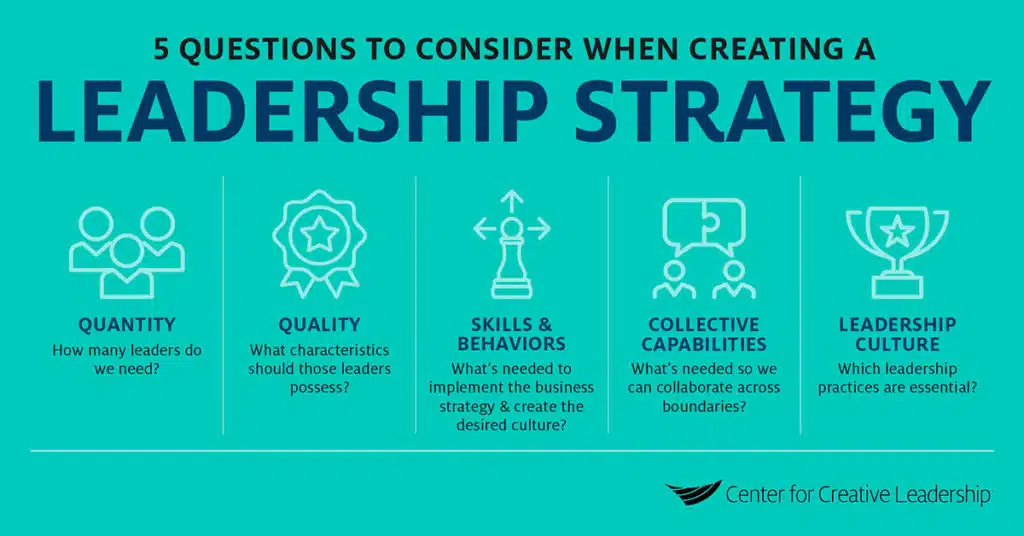Organizations depend on capable leadership to guide them through unprecedented changes. Yet there’s ample evidence that even some of the most established organizations are failing to adapt to change, implement their strategic plans successfully, or prepare for an uncertain future.
What can your organization do to avoid the risks associated with inadequate leadership strategy and better prepare your current and future leaders for unforeseen changes?
What Is a Leadership Strategy?
A leadership strategy is a map that aligns investments in leadership development with the strategy, goals, and aspirations of the business.
A leadership strategy makes explicit how many leaders are needed, what kind, where they’re needed, with what skills, and behaving in what fashion, both individually and collectively to achieve the desired outcomes.
It also identifies other issues the organization must consider, such as whether current talent systems (like onboarding or performance management) support the culture and leadership the organization wants to create.
Why You Need a Leadership Strategy
Every leader is aware that a well-defined business strategy is important. But few give thought to the leadership strategy that’s needed to make it happen.
Too often, organizations hold onto an old list of leadership competencies (or just keep endlessly adding to their existing list). Others create talent programs that are too generalized by not factoring in the specific business strategies of their organization.
This disconnected approach to developing organizational and individual leadership won’t equip senior management, up-and-coming talent, or everyday leaders to adapt to change and meet new goals.
When setting bold strategies that call for changes in the direction or capabilities of the organization, consider the leadership gap. One of the first questions to ask is: Do we have the leadership we need for the strategy we’ve set?
How to Create a Leadership Strategy
This is our recommended process to create a leadership strategy that we outline in our white paper:
First, Start With Your Leadership Drivers
The first step in developing a leadership strategy is to determine your organization’s key leadership drivers — the 3-5 determinants of sustainable competitive advantage for your particular organization in your particular industry.
You can’t create a leadership strategy that will be effective without this first critical step.
Then, Identify Leadership Strategy Implications
Once you’ve determined the key drivers, leadership strategy implications can be identified. For example, if becoming more innovative is a key driver for your organization, then the leadership strategy implications may be as follows:
- Greater interdependence among leadership to create more effective collaboration across functions in bringing new products to market.
- A need to increase leadership involvement across functions in gathering consumer insights and translating these into profitable ideas for new products.
- Anticipating capital, space, and talent implications of rapidly expanding product portfolio.
- A need for cultural change to create a spirit of innovation versus a culture of risk aversion.
In reality, the leadership strategy implications would be much more specific, reflecting the actual opportunities and issues surrounding the key drivers. The key drivers and their associated business strategies should have clear implications for what leaders must do well in order for the organization to succeed.
Ultimately, leadership development activities should be designed to ensure that individual leaders and the collective leadership of the organization are prepared to implement the most important strategies related to the key drivers.
5 Factors for Creating a Leadership Strategy
Setting a leadership strategy first requires a comprehensive understanding of leadership in your organization. This begins with individual talent and competencies, but it doesn’t end there. The ability of formal and informal leaders to pull together ultimately makes the difference in whether you accomplish your goals.
A comprehensive leadership strategy translates these strategy drivers into specific action and should take the following 5 factors into account:
- Quantity of leaders needed, as indicated by current and projected formal leadership positions depicted on an organization chart (number, level, location, function, business unit, and reporting relationships). Ask: How many leaders do we need? What are the current and projected leadership positions on the org chart? What about informal leadership positions?
- Qualities desired in these leaders (demographics, diversity, background, experience level). Ask: What characteristics should individual leaders possess? Who needs to be represented or included?
- Skills and behaviors that are needed to implement the business strategy (knowledge base, leadership competencies, etc.). Ask: What skills, competencies, knowledge, and behaviors are needed to implement the business strategy and create the desired culture?
- Collective leadership capabilities of leaders acting together in groups and collaboration across boundaries to implement strategies, solve problems, respond to threats, adapt to change, and support innovation. Ask: What capabilities do we need so we can act together in groups and across boundaries to implement strategies, solve problems, respond to threats, adapt to change, or support innovation?
- Desired leadership culture — including the leadership practices in use — to create the leadership culture, such as engagement of employees, accepting responsibility for outcomes, creating opportunities for others to lead, developing other leaders, and learning how to learn. Ask: What are the key attributes of the desired leadership culture? What leadership practices are essential, such as boundary-spanning, employee engagement, or creating opportunities for others to lead?
Developing the leadership strategy needed to implement the business strategy takes careful planning, dedicated effort, and commitment from your organization.
But by going through the leadership strategy development process, you open the door for more targeted, effective leadership development — and an organizational culture capable of achieving strategic success.
Ready to Take the Next Step?
We can partner with you to help your organization create a leadership strategy that supports and aligns with your business strategy.









